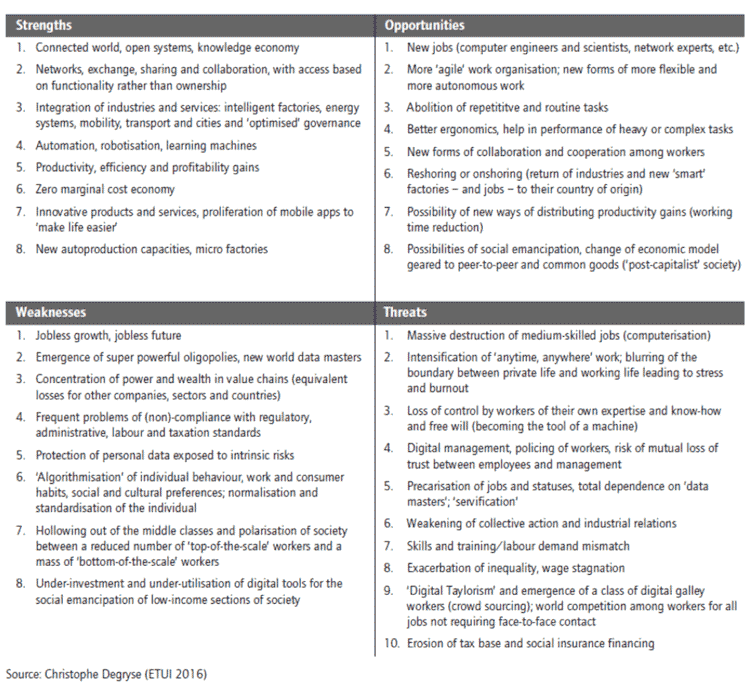The newest technologies seem to be promising us a truly radiant future: robots whose skills become more refined with every passing day; increasingly numerous and wide-ranging digital data aggregated at an ever faster pace to form something resembling an embryonic global artificial brain; algorithms capable of profiling individuals and identifying their cultural and social preferences; and even cars not requiring drivers and 3D printers that will soon enable you to print your own car or your new home!
Such is the universe of magical innovations promised by the 4th industrial revolution. Cause for rejoicing? No doubt. The true sharing economy – that is to say one that strengthens social links and communities (not the Uber or Airbnb version in which the overwhelming concern is profit) – opens up new prospects for cooperation, and nothing less than a complete change of economic paradigm, as announced by writers such as Michel Bauwens.
Social And Labour Impacts
But this 4th industrial revolution also contains its share of new risks in the world of labour, including the ‘remake’ of existing jobs, the destruction of many of them, the relocation of countless others. For society as a whole, it is a prospect accompanied by the threat of increased polarisation between the ‘winners’ and the ‘losers’ of the digital economy.
Jobs ‘remade’
Already today, in the so-called ‘smart’ companies and factories, employees are working with and alongside their new ‘colleagues’ who, increasingly, are ever more highly sophisticated robots. On assembly lines, robots are frequently able to lighten heavy work and facilitate the most complex tasks. Yet, as these robots gain in intelligence and increasingly refine their skills, one increasingly vital question is ‘who is the tool of whom?’ Are we not already beginning to witness a reversal between the role of the human worker and that of the machine?
Alongside unquestionable advantages in terms of ergonomics, other – too frequently neglected – issues emerge in the field of labour sociology. The fact that a worker’s expertise and know-how can be replaced by machines and algorithms will have major consequences for employees’ identity in the workplace as well as for human resources management. The same goes for the new employee-monitoring systems that have already gained widespread currency. Workers’ actions and movements are recorded by RFID tags, a wide range of multi-purpose communication and connection devices, IP cameras, software programmes, and so forth. Delivery workers or maintenance technicians, whose managements previously allowed them some considerable degree of organisational autonomy, are now trackable via their satnavs and other composite mobile devices, so that a continuous check can be kept on their routes, their stops, their detours.
The risk of this digital management, aimed at optimising each and every movement and action, is that it will culminate in reification of the worker who comes to be regarded as a mere tool whose use value is to be exploited to the maximum. This seems clearly tantamount to a violation of the worker’s dignity and likely to lead to loss of trust between employees and their management.
Jobs lost
While there is no consensus in the academic community as to the detailed impact of the 4th industrial revolution in terms of job creation/destruction, there is consensus on the fact that the net outcome will be negative: automation, computerisation, robotics all destroy more jobs than they create.
In relation to the United States, writers estimate the number of jobs threatened by new technologies at around 47% of the total. ‘Threatened’ refers to the risk of becoming automated by computerised equipment in the next ten to twenty years. What kind of jobs are we talking about? Office work, administrative support, sales, commerce, transport, logistics, manufacturing, construction, as well as virtually all services that lend themselves to automation or relocation: translation, accounting, personal assistance, etc.
In relation to Europe, estimates set possible job losses at between 40% and 60%. There are those who believe that these are exaggerated ‘horror scenarios’. Yet, even if the forecasts may well be somewhat off the mark, the threat remains real: not only are routine and repetitive tasks already being digitalised but, in addition, an increasing number of complex tasks are tomorrow likely to be taken over and performed by computerised devices.
Authors such as Brynjolfsson, McAfee, Frey, Osborne, or Ford announce, for example, that virtually all those services that do not require face-to-face human contact will be either relocated or digitalised. This even includes such highly skilled – and sometimes highly paid – services as tax consulting, professional coaching, translation, etc.
Jobs relocated and made precarious
This computerisation/digitalisation goes hand in hand with new forms of production. Large digital platforms today offer employers a labour supply consisting of millions of ‘crowdworkers’ located all over the world and prepared to carry out small (or large) tasks that even the most advanced computers are not yet capable of performing: data entry, sorting photos, cleaning up forums, standardising postal addresses, finding email addresses, evaluating tweets, recording comments, etc.
These crowdworkers are paid either a piecework rate, amounting to a few cents per task, or an hourly rate, beginning at less than three dollars an hour. Amazon has had the ‘amusing’ idea of labelling these service suppliers ‘mechanical Turks’ (see its Amazon Mechanical Turk platform). In the shadow of the 4th industrial revolution, with its digital Taylorism, a new class of workers is thus currently emerging where the Filipino data entry worker is competing with his Californian, Spanish, Indian or Finnish counterparts. Without social security cover and subject to zero regulation, needless to say.
Regarded from this angle, the new technologies could well precipitate numerous workers into the 19th century world of labour commodification so vividly described by Karl Polanyi – a development that can hardly be regarded as progress.
Polarisation
Taken together, these three phenomena that are already to be observed on labour markets (job remakes, job losses, job relocations) threaten to drive society into a state of extreme polarisation. It is true that the weakening of the middle classes and the concomitant increase in inequality are not new phenomena either in Europe or in the United States. Yet this evolutionary trend, driven by numerous economic and political factors, is threatening to gain vigour and momentum through the social and labour effects of the digital revolution.
While this revolution will lead to considerable increases in productivity, it is – in the framework of an ever less labour-intensive economy – the medium-level, medium-skilled and medium-paid jobs that will be the most predominantly squeezed out. This ‘hollowing out’ of the middle classes will create increasingly polarised societies with, on the one hand, the highly skilled and hard-to-come-by jobs in the fields of computer sciences, engineering, networks, etc. These are jobs accessible to the ‘superstars’ among workers. On the other hand, we will witness an explosion of very low-skilled jobs, data entry/sorting/filtering workers, those whom Irani has described as the ‘data janitors’. What is more, and contrary to what happened in the 20th century, it is likely that, however much effort is deployed in the development of training, it will prove quite impossible to devise and put in place a structural solution that would enable all workers to benefit from the new prosperity that is announced.
A secondary effect of this polarisation, moreover, is that it will drag down the financing of social security and erode the tax base. The new economy wreaks havoc with some aspects of existing statutory and regulatory frameworks: take, for example, the case of a German employer posting on a digital platform located in the United States a task that will be performed by a Brazilian worker. The start-ups that are today calling the tune are geared to rapid growth and display the utmost disregard for compliance with existing regulations and legislation. The likely outcome of such a trend is a gradual collapse of labour standards and social models at the same time as a relentless blurring of the boundary between private life and work, a sidestepping of health and safety regulations, and intensification of an ‘anytime, anywhere’ attitude to work.
While it would of course be nonsensical to advocate a halt to technological progress, there is a pressing need to flesh out the scenario of a radiant digital future with an analysis of its impact on society and the world of labour, in order to anticipate the effects. The digital revolution, left to its own devices, risks creating more top-of-the-scale jobs for some, and mini-jobs or unemployment for the rest; more freedom for the few, more servitude for the many; more prosperity for the privileged, more precarious conditions for the masses.
It is a scenario that can be avoided if the political and economic actors can agree to join forces and to invite academic, cultural, social and trade union stakeholders into the debate.
Translation from the French by Kathleen Llanwarne. Christophe Degryse is also author of the working paper ‘Digitalisation of the economy and its impact on labour markets’
Summary of the main issues examined in this study broken down into ‘strength/weakness’ and ‘opportunity/threat’ (SWOT) categories

This contribution is part of our project on the future of work and the digital revolution.
Christophe Degryse is head of the Foresight Unit at the European Trade Union Institute.

